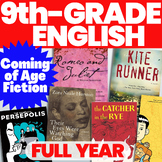THE COMPLETE PERSEPOLIS Unit Plan: Discussion Questions, Worksheets, & Writing
- Zip
What educators are saying
Also included in
- UPDATED FOR THE 2023-2024 SCHOOL YEAR: Full-Year Curriculum! Diverse Authors! Discussion-Based! This MEGA-BUNDLE has everything you'll need to teach a year-long 9th-grade English course on Coming-of-Age Literature. The focus of this course is coming-of-age novels, plays, and poems written by diversePrice $99.99Original Price $198.93Save $98.94
Description
NEW IN 2020: Rigorous! Thought-provoking! Discussion-based!
This 75-page EDITABLE unit has everything you'll need for profoundly stimulating lessons on Marjane Satrapi's The Complete Persepolis. Invite your class to engage in student-driven discussions without compromising on intellectual rigor. The discussion questions, quick writes, daily quizzes, and final writing assignment will challenge your students to dig beneath the surface of the text and generate profound interpretive insights!
The graphic novel is an aesthetically innovative genre in which meaning is created through the interplay of image and text. How do we read a novel in which two narrative channels — one verbal, the other visual — interact? And how do graphic novels challenge readers to expand the set of interpretive techniques that make up “close reading”? This bundle will help students understand complex questions about literary genres, aesthetic form, coming-of-age novels, cross-cultural encounters, and the social and political history of Iran!
Hold your students accountable for completing the nightly homework by beginning every class with a quick vocabulary and reading quiz. Facilitate dynamic discussions that motivate students to become attached to the thrill generating shared knowledge. Challenge students to explicate textual details using a wide range of interpretive lenses: formalist, historicist, psychoanalytic, feminist, etc. Inspire students to arrive at a whole new depth of insight!
Everything you’ll need to teach The Complete Persepolis is included in this bundle:
• Unit & Pacing Guide: Suggestions for how to pace the reading homework and organize the classwork for Satrapi's graphic novel. (2 pages)
• Graphic Novel Glossary: A glossary of literary elements that are unique to the genre of the graphic novel: panel, tier, gutter, etc. Help your students learn to use the correct terminology when referring to the different features on any given page. (1 page)
• Discussion Questions: Eighteen of higher-order discussion questions guaranteed to inspire profoundly thoughtful class discussions! This unit features double-sided handouts containing 8-10 questions for each of the novel's 9 sections. The discussion questions are the beating heart of these lesson plans! They challenge students to build interpretive arguments that require the support of carefully selected textual evidence — leading to keen interpretive insights! The questions could be used to focus students’ thinking prior to beginning a discussion, to foster in-class quick writes, or to assign written reflections for homework. Guaranteed to elicit student engagement and foster profound discussions! (18 pages)
• Quick Writes: A "quick write" can be used at any time in a class to get students to pause and reflect on the text in writing. Introduce a quick write before you begin a discussion to allow your more reticent students to collect their thoughts. Or roll one out toward the end of a discussion to let students capture and refine their best ideas. (9 pages)
• Image Analysis Worksheet: A two-page worksheet inviting students to analyze 10 visually complex panels from Persepolis. Students will reflect on how Satrapi builds meaning by drawing on a distinctive palette of literary and artistic techniques: symbolic imagery, dramatic irony, high contrast, patterning, juxtaposition, etc. Students are challenged to analyze how the visual aesthetics of different panels contributes to the book's meaning. Answer key included. (4 pages)
• Quotation Race Worksheets: Students work in pairs to identify the speakers of 25 quotations. One worksheet features 15 memorable quotes from the main characters. A second worksheet features 10 challenging quotations from secondary characters. Introduce this fun activity when you need to mix things up. Answer key included. (4 pages)
• Vocabulary Lists: Lists of 10-12 vocabulary words accompany each nightly reading assignment. Every word comes with a definition as well as a sample sentence with the word as used in Persepolis. A total of over 100 words. (9 pages)
• Vocabulary & Reading Quizzes: Daily quizzes with 10 questions to follow each nightly reading assignment. Each quiz contains 7 questions on vocabulary words plus another 3 questions on reading comprehension. Grading these quizzes is simple and quick — an easy way to log 9 grades into your gradebook. Answer key included. (18 pages)
• Analytical Writing Assignment: Challenge students to take their interpretations one step further by writing an analytical paper on Satrapi's wonderfully complex graphic novel. Let students choose from one of five profoundly thought-provoking sample topics — or invite them to develop a topic of their own. Rubric included. (3 pages)
• Writing Schedule & Rubric: A writing schedule with instructions for completing each stage of the writing process. Rubric included. (2 pages)
This resource packet will come to you in two separate formats: Word docs *and* PDFs. Because the Word docs are fully editable, you'll be able to customize the materials to suit your teaching style and/or your students' skill levels — year after year! If you don't have Microsoft Word, you'll still be able to access all of the materials in PDFs, which are easy to navigate and quick to print!
My store is called “Rigorous Resources” because the units feature rigorous content guaranteed to yield an abundance of interpretive insights. The preview for this resources provides direct access to over 30 pages of materials. Click on the green “PREVIEW” button to see what you’ll get. . . .
Thank you for choosing “Rigorous Resources”!
Happy teaching!
Adam Jernigan, Ph.D.
adamjernigan@gmail.com
P.S. Don't forget to click “follow” for email updates on new products by Rigorous Resources. New products will be 50% OFF for the first 24 hours!






